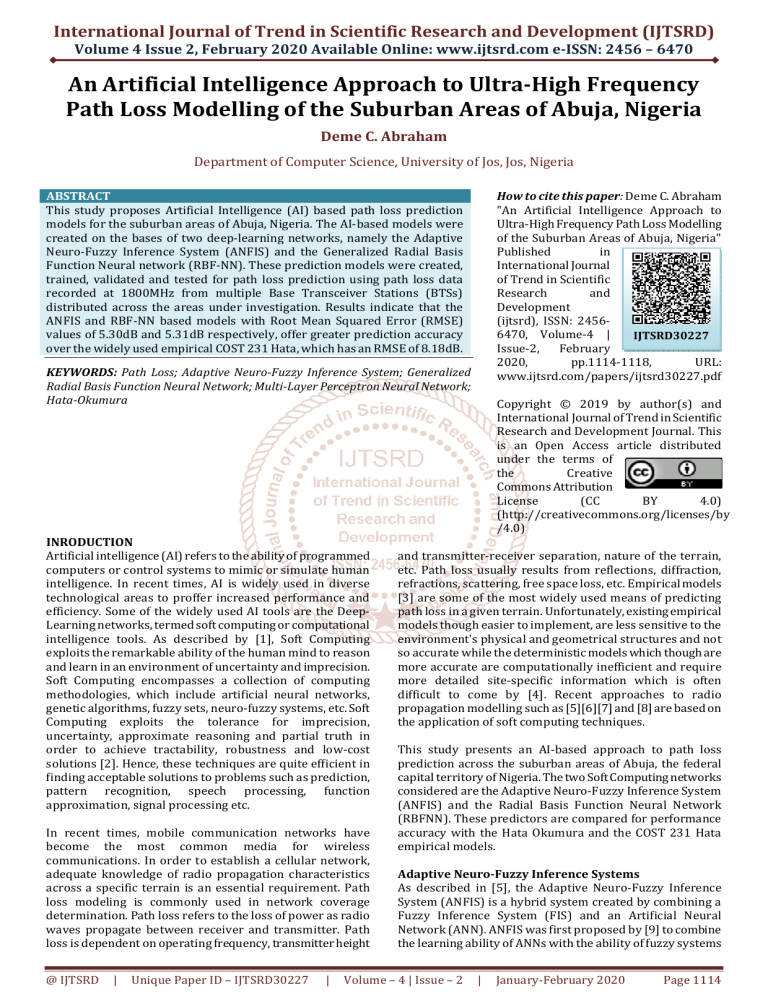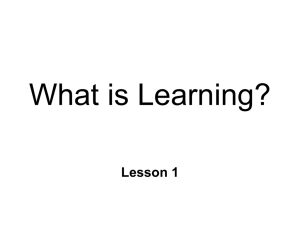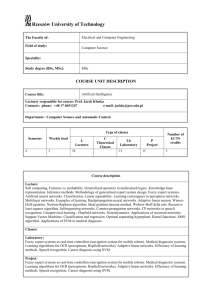
International Journal of Trend in Scientific Research and Development (IJTSRD)
Volume 4 Issue 2, February 2020 Available Online: www.ijtsrd.com e-ISSN: 2456 – 6470
An Artificial Intelligence Approach to Ultra-High Frequency
Path Loss Modelling of the Suburban Areas of Abuja, Nigeria
Deme C. Abraham
Department of Computer Science, University of Jos, Jos, Nigeria
How to cite this paper: Deme C. Abraham
"An Artificial Intelligence Approach to
Ultra-High Frequency Path Loss Modelling
of the Suburban Areas of Abuja, Nigeria"
Published
in
International Journal
of Trend in Scientific
Research
and
Development
(ijtsrd), ISSN: 24566470, Volume-4 |
IJTSRD30227
Issue-2,
February
2020,
pp.1114-1118,
URL:
www.ijtsrd.com/papers/ijtsrd30227.pdf
ABSTRACT
This study proposes Artificial Intelligence (AI) based path loss prediction
models for the suburban areas of Abuja, Nigeria. The AI-based models were
created on the bases of two deep-learning networks, namely the Adaptive
Neuro-Fuzzy Inference System (ANFIS) and the Generalized Radial Basis
Function Neural network (RBF-NN). These prediction models were created,
trained, validated and tested for path loss prediction using path loss data
recorded at 1800MHz from multiple Base Transceiver Stations (BTSs)
distributed across the areas under investigation. Results indicate that the
ANFIS and RBF-NN based models with Root Mean Squared Error (RMSE)
values of 5.30dB and 5.31dB respectively, offer greater prediction accuracy
over the widely used empirical COST 231 Hata, which has an RMSE of 8.18dB.
KEYWORDS: Path Loss; Adaptive Neuro-Fuzzy Inference System; Generalized
Radial Basis Function Neural Network; Multi-Layer Perceptron Neural Network;
Hata-Okumura
INRODUCTION
Artificial intelligence (AI) refers to the ability of programmed
computers or control systems to mimic or simulate human
intelligence. In recent times, AI is widely used in diverse
technological areas to proffer increased performance and
efficiency. Some of the widely used AI tools are the DeepLearning networks, termed soft computing or computational
intelligence tools. As described by [1], Soft Computing
exploits the remarkable ability of the human mind to reason
and learn in an environment of uncertainty and imprecision.
Soft Computing encompasses a collection of computing
methodologies, which include artificial neural networks,
genetic algorithms, fuzzy sets, neuro-fuzzy systems, etc. Soft
Computing exploits the tolerance for imprecision,
uncertainty, approximate reasoning and partial truth in
order to achieve tractability, robustness and low-cost
solutions [2]. Hence, these techniques are quite efficient in
finding acceptable solutions to problems such as prediction,
pattern recognition, speech processing, function
approximation, signal processing etc.
In recent times, mobile communication networks have
become the most common media for wireless
communications. In order to establish a cellular network,
adequate knowledge of radio propagation characteristics
across a specific terrain is an essential requirement. Path
loss modeling is commonly used in network coverage
determination. Path loss refers to the loss of power as radio
waves propagate between receiver and transmitter. Path
loss is dependent on operating frequency, transmitter height
@ IJTSRD
|
Unique Paper ID – IJTSRD30227
|
Copyright © 2019 by author(s) and
International Journal of Trend in Scientific
Research and Development Journal. This
is an Open Access article distributed
under the terms of
the
Creative
Commons Attribution
License
(CC
BY
4.0)
(http://creativecommons.org/licenses/by
/4.0)
and transmitter-receiver separation, nature of the terrain,
etc. Path loss usually results from reflections, diffraction,
refractions, scattering, free space loss, etc. Empirical models
[3] are some of the most widely used means of predicting
path loss in a given terrain. Unfortunately, existing empirical
models though easier to implement, are less sensitive to the
environment's physical and geometrical structures and not
so accurate while the deterministic models which though are
more accurate are computationally inefficient and require
more detailed site-specific information which is often
difficult to come by [4]. Recent approaches to radio
propagation modelling such as [5][6][7] and [8] are based on
the application of soft computing techniques.
This study presents an AI-based approach to path loss
prediction across the suburban areas of Abuja, the federal
capital territory of Nigeria. The two Soft Computing networks
considered are the Adaptive Neuro-Fuzzy Inference System
(ANFIS) and the Radial Basis Function Neural Network
(RBFNN). These predictors are compared for performance
accuracy with the Hata Okumura and the COST 231 Hata
empirical models.
Adaptive Neuro-Fuzzy Inference Systems
As described in [5], the Adaptive Neuro-Fuzzy Inference
System (ANFIS) is a hybrid system created by combining a
Fuzzy Inference System (FIS) and an Artificial Neural
Network (ANN). ANFIS was first proposed by [9] to combine
the learning ability of ANNs with the ability of fuzzy systems
Volume – 4 | Issue – 2
|
January-February 2020
Page 1114
International Journal of Trend in Scientific Research and Development (IJTSRD) @ www.ijtsrd.com eISSN: 2456-6470
to interpret imprecise information, and it was based on the
first-order Takagi–Sugeno (TS) model. ANFIS is an intelligent
adaptive system capable of solving complex non-linear
problems. ANNs are quite useful in modelling systems where
there is no mathematical relationship between input and
output patterns. This stems from the fact that, as systems
that mimic the human brain, ANNs can be trained using
input patterns and target output, and then used to predict a
result given new sets of inputs. Based on the concepts of
fuzzy set theory, fuzzy if-then rules, and fuzzy reasoning, FIS,
on the other hand, is a computational network capable of
modelling human knowledge and reasoning.
The ANFIS predictor considered in this study is based on the
model proposed by [10], referred to as the First Order
Sugeno Fuzzy Model (or simply the TS Model) shown in Fig
1. The ANFIS architecture based on the TS model is
presented in Fig. 2, with two inputs, x and y and one output
which is a function of the inputs.
These functions are defined by Membership Functions (MF)
which can either be Bell, Gaussian or Triangular. The most
widely used MF is the Bell MF given by (3).
µ Ai ( x) =
1
x − ci
1+
ai
(3)
2 bi
Layer 2: This layer comprises of fixed nodes and the output
of every node is the product of all the incoming signals into
the node as given by (4). These node outputs are the firing
strengths of the rules.
wi = µ Ai ( xi ) Xµ Bi ( y i )
(4)
Based on the TS Model, the two if-then-else rules are as
follows:
1. If (x is A1) and y is B1, THEN f1 = p1 x + q1 y + r1
2. If ( x is A2) and y is B2, THEN f2 = p2 x + q2 y + r2
Layer 3: This layer also comprises of fixed nodes, which are
denoted by N. This is the normalization layer where the ratio
of the firing strength of each rule is calculated with respect
to the sum of the firing strengths of all rules, using (5).
Hence, the outputs of this layer are referred to as normalized
firing strengths.
The linguistic labels Ai and Bi are fuzzy sets associated with
the input nodes x and y respectively, and fi is a non-fuzzy
function which depends on the inputs x and y.
wi =
As shown in Fig. 2, the ANFIS architecture comprises of five
layers and each layer is defined by specific nodes, which can
either be fixed or adaptive. A fixed node is denoted by a
circle while a square represents an adaptive node.
Layer 1 : In this layer, every node is an adaptive node with a
node function given by (1) and (2):
wi
2
(5)
∑ wj
j =1
Layer 4: The nodes in this layer are adaptive nodes. The
output of each node is the product of the normalized firing
strength and a first order polynomial (for the first order TS
model), given by (6):
wi f i = wi ( pi x + qi y + ri )
(6)
The parameters pi, qi and ri are called consequent
parameters.
Fig. 1: First Order Sugeno Model (Liang et al, 2012)
Layer 5 This is the output layer and it has a single fixed node
labeled ∑. The layer computes the overall output as the
summation of all incoming signals, to produce a crisp output
given by (7).
f ( x, y ) = ∑ wi f i
i
∑w f
=
∑w
i
i
i
(7)
i
i
Fig. 2: The Architecture of an Adaptive Neuro-Fuzzy
Inference System
(1)
(2)
@ IJTSRD
|
Unique Paper ID – IJTSRD30227
|
According [9], ANFIS uses a hybrid learning algorithm
comprising of gradient descent back-propagation and the
least-squares approximation method. During network
training the back-propagation algorithm determines the
premise parameters while the least-squares approximation
method determines the consequent parameters.
The Generalized Radial Basis Function Neural Network
The generalized Radial Basis Function Neural Network (RBFNN) is also widely used in solving function approximation
problems. The generalization is equivalent to the use of this
multi-dimensional surface to interpolate the test data [11].
As described in [11], a RBF-NN network comprises of the
Volume – 4 | Issue – 2
|
January-February 2020
Page 1115
International Journal of Trend in Scientific Research and Development (IJTSRD) @ www.ijtsrd.com eISSN: 2456-6470
input layer, hidden layer and output layer. One neuron in the
input layer corresponds to each predictor variable. With
respects to categorical variables, n-1 neurons are used
where n is the number of categories. The hidden layer has a
variable number of neurons. Each neuron consists of a radial
basis function centered on a point with the same dimensions
as the predictor variables. The output layer has a weighted
sum of outputs from the hidden layer to form the network
outputs. The output of each hidden-node, φk is obtained by
the closeness of input X to an M-dimensional parameter
vector µk associated with the kth hidden node. The RBF–NN
layers are shown in Fig. 3.
1. The input layer
2. The hidden layer, where input data undergoes nonlinear
transformation
3. The linear output layer, where the outputs are produced
measured in some statistical sense [11]. The training of a
RBFNN is in two stages:
1. Determination of radial basis function parameters, i.e.,
Gaussian centre and spread width
2. Determination of output weight by supervised learning.
The Cost 231 Hata Model
As described in [6], the COST 231 Hata Model was derived
from the Hata Model by the European Cooperative for
Scientific and Technical research, to suit the European
environments taking into consideration the frequency range
0.5GHz to 2GHz. This model is suitable for path loss
prediction in urban, semi-urban, suburban and rural areas.
The model expression is given by (10)
(10)
φ1 (x)
x1
1
w1
x2
φk (x)
k
wk
y
i
wK
xm
φK (x)
xM
K
Hidden layer
Input layer
Output layer
Fig. 3: The Generalized Radial Basis
Function Neural Network [11].
The most popular choice for the function ϕ is a multivariate
Gaussian function with an appropriate mean and auto
covariance matrix [11]. The output of a Radial Basis Function
Neural Network is given by (8).
(8)
where,
X is the input vector
Wik is the connection weight in the second layer (from
hidden to output layer)
k is the number of hidden nodes
i denotes the i-th hidden node
φk is the radial basis activation function.
As described in [12], the radial basis function is a multidimensional function that describes the distance between a
given input vector and a pre-defined centre vector. The
Gaussian function is a type of radial basis function given by
(9)
X −µ
k
ϕ k = exp −
2
2σ k
2
Unique Paper ID – IJTSRD30227
|
(11)
Where,
Lp is the computed path loss
EIRP is the Effective Isotropic Radiated Power
PR is the received signal power
(9)
The learning process is equivalent to finding a surface in a
multidimensional space that provides a best fit to the
training data, with the criterion for the “best fit” being
|
Materials and Methods
A. Received Power Measurement and Path Loss
Computation
Received power measurements were recorded from multiple
Base Transceiver Stations (BTSs) situated within the
suburban areas of Abuja, namely Kubwa and Kuje, with
average building heights mostly below 15m. The Base
Stations belong to the mobile network service provider,
Mobile Telecommunications Network (MTN), Nigeria. The
instrument used was a Cellular Mobile Network Analyser
(SAGEM OT 290) capable of measuring signal strength in
decibel milli watts (dBm). Received power (PR) readings
were recorded within the 1800MHz frequency band at
intervals of 0.05km away from the BTS. Corresponding path
loss values (LP), were computed using (11).
LP=EIRP - PR
Where,
µk denotes the center vector
σk denotes the spread (width) of the function
@ IJTSRD
Where,
L = Median path loss in Decibels (dB)
C=0 for medium cities and suburban areas
C=3 for metropolitan areas
f = Frequency of Transmission in Megahertz
(MHz)(500MHz to 200MHz)
hB = Base Station Transmitter height in Meters (30m to
100m)
d = Distance between transmitter and receiver in
Kilometers (km) (up to 20kilometers)
hm = Mobile Station Antenna effective height in Meters
(m) (1 to 10metres)
a(hm) = Mobile station Antenna height correction factor
as described in the Hata Model for Urban Areas.
For urban areas, a(hm) = 3.20(log10(11.75hr))2−4.97, for
f > 400 MHz
For sub-urban and rural areas, a(hR) = (1.1log(f) - 0.7)hR
- 1.56log(f) -0.8
Mobile Network Parameters obtained from the Network
Provider (MTN) include Mean Transmitter Height of 28
meters and Mean Effective Isotropic Radiated Power (EIRP)
of 43dBm.
Volume – 4 | Issue – 2
|
January-February 2020
Page 1116
International Journal of Trend in Scientific Research and Development (IJTSRD) @ www.ijtsrd.com eISSN: 2456-6470
Results and Analysis
The performance comparison of the AI-based models and the
empirical model is based on the Root Mean Square Error
(RMSE), given by (12), and the Coefficient of Determination
(R2), given by (13). The RMSE is a measure of the differences
between predicted and observed values. R2 ranges between
0 and 1, but can be negative, which indicates the model is
inappropriate for the data. A value closer to 1 indicates that a
greater correlation of the model with test data.
(12)
Where,
M – Measured Path Loss
P – Predicted Path Loss
N- Number of paired values
Fig. 6: Model Comparison for BTS 3
(13)
Where
yi is the measured path loss,
is the predicted path loss and
is the mean of the measured path loss values.
Fig. 7: Model Comparison for BTS 4
Fig. 4: Model Comparison for BTS 1
Fig. 8: Model Comparison for BTS 5
Fig. 5: Model Comparison for BTS 2
Fig. 9: Model Comparison for BTS 6
@ IJTSRD
|
Unique Paper ID – IJTSRD30227
|
Volume – 4 | Issue – 2
|
January-February 2020
Page 1117
International Journal of Trend in Scientific Research and Development (IJTSRD) @ www.ijtsrd.com eISSN: 2456-6470
Table 1: Statistical Performance Comparison of Predictors
STATS.
BST 1 BST 2 BST 3 BST 4 BST 5 BST 6
RMSE(dB) 4.38
5.38
5.48
4.47
4.59
7.59
RBF-NN
R2
0.80
0.72
0.76
0.76
0.83
0.61
RMSE(dB) 3.97
3.74
5.76
4.61
5.64
8.08
ANFIS
R2
0.83
0.87
0.73
0.75
0.74
0.56
RMSE(dB) 4.80
6.96
11.22 11.08
7.30
7.70
COST
231 Hata
R2
0.88
0.59
0.16
-0.19
0.65
0.58
MODEL
MEAN
5.31
0.75
5.30
0.75
8.18
0.44
During neural network training, validation and testing, the set of recorded path loss values from each BTS was randomly split
into 50% for training, 10% for validation and 40% for testing. Figs. 4 to 9 depict graphical performance comparisons of all
predictors considered. It can be clearly observed that the COST 231 Hata slightly overestimates the path loss in figures 6 and 7.
However, a convergence in performance of the three predictors can be observed in the other figures. The performance indices
in Table 1 indicate that the AI- based predictors with a mean RMSE value of 5.3dB offer greater prediction accuracy over the
COST 231 Hata. Furthermore, with R2 values of 0.75, the AI-based models exhibit greater fit over the COST 231 Hata, which has
0.44.
Conclusion
Artificial Intelligence based models were trained, validated
and tested using data obtained at an operating frequency of
1800MHz, from multiple Base Stations located within the
suburban areas of Abuja, Nigeria. The AI-based models were
created on the bases of two deep learning networks, namely,
the Adaptive Neuro-Fuzzy Inference System (ANFIS) and the
Generalized Radial Basis Function Neural network (RBFNN). A performance comparison of the AI-based models with
the widely used COST 231 Hata empirical counterpart
indicate that on the average, the AI-based techniques offer
an improvement of about 3dB over the COST 231 Hata.
Hence, the AI-based models are recommended for path loss
prediction at 1800MHz, across the terrain under
investigation.
References
[1] Jang J. S. “Adaptive Network Based Fuzzy Inference
System”, IEEE Trans. On Systems Man. and Cybemetics,
Vol.23, No.3, 1993, pp 665-685
[2] Santosh K. D., Sachin T., Burnwal A. P. “Some Relevance
Fields of Soft Computing Methodology”. International
Journal of Research In Computer Applications And
Robotics, ISSN 2320–7345, 2014, pp. 1-6.
[3] Kiran J. P. and Vishal D. N. “Comparative Analysis of
Path Loss Propagation Models in Radio
Communication”. International Journal of Innovative
Research in Computer and Communication
Engineering. Vol. 3, Issue 2, February 2015
[4] Abhayawardhana V. S., I. J. Wassel, D. Crosby, M. P.
Sellers, M.G. Brown Comparisonof empiricalpropagationpath
loss models for fixed wireless access systems. 61th
IEEE Technology Conference, Stockholm, 2005, pp. 73-77.
[5] Deme A. C. “Computational Intelligence Approach to
Mobile Network Coverage Determination across a
typical Guinea Savanna Belt Rural Terrain”. Journal of
Multidisciplinary Engineering Science and Technology
@ IJTSRD
|
Unique Paper ID – IJTSRD30227
|
(JMEST) ISSN: 2458-9403 Vol. 6 Issue 12, pp 1131211319, 2019
[6] Deme A. C. “Radio Propagation Modelling of a Typical
Sudan Savanna Belt Rural Terrain using Softcomputing and Empirical Techniques”. Journal of
Multidisciplinary Engineering Science and Technology
(JMEST) ISSN: 2458-9403 Vol. 6 Issue 12, pp 1132011325, 2019
[7] Joseph M. M, Callistus O. M, and Gabriel A. I. Application
of Artificial Neural Network for Path Loss Prediction In
Urban Macrocellular Environment. American Journal of
Engineering Research-ISSN: 2320-084, 2014, pp 270275
[8] Callistus O. M, Joseph M. M, and Gabriel A. I.
Performance Evaluation of Generalized Regression
Neural Network Path loss Prediction Model in
Macrocellular
Environment.
Journal
of
Multidisciplinary Engineering Science and Technology
(JMEST) ISSN: 3159-0040, 2015, pp. 2004 – 2008.
[9] Jang J. S. Adaptive Network Based Fuzzy Inference
System”, IEEE Trans. On Systems Man. and Cybemetics,
Vol.23, No.3, 1993, pp 665-685
[10] Takagi T., Sugeno M., “Fuzzy identification of systems
and its applications to modeling and control”, IEEE
Trans. on Systems, Man and Cybernetics, Vol. 15, No. 1,
pp. 116-132, 1985.
[11] Popescu, I., Kanatas, A., Angelou, E., Nafornita, I., &
Constantinou, P. Applications of generalized RBF-NN for
path loss prediction. 13th IEEE International
Symposium on Personal, Indoor and Mobile Radio
Communications (PIMRC 2002), 1, 2002, 484–488.
[12] Tsung-Ying S., Chan-Cheng L., Chung-Ling L., Shent-Ta
H., Cheng-Sen H. A Radial Basis Function Neural
Networks with Adaptive Structure via Particle Swarm
Optimisation, 2014, pp.423-437
Volume – 4 | Issue – 2
|
January-February 2020
Page 1118






